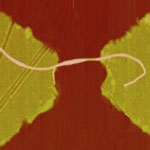Showing Spotlights 161 - 168 of 318 in category All (newest first):
 Infrared (IR) detectors are used in imaging applications that include for instance medical diagnosis, environmental monitoring, space science, and security and military sensor devices. High-quality detectors require cryogenic cooling in order for the image not to be distorted by the detectors own radiation. This makes them expensive both to produce and to run. Although uncooled IR detectors are made, their resolution and image quality tend to be much lower than cooled detectors. It appears that carbon nanotubes (CNTs) could be used as novel IR detector material that would allow the fabrication of highly efficient detectors that do not require cooling. Researchers at Michigan State University have now, for the first time, experimentally demonstrated the design, manufacturing and experimental testing of an integrated nanoantenna concept for CNT based IR sensors.
Infrared (IR) detectors are used in imaging applications that include for instance medical diagnosis, environmental monitoring, space science, and security and military sensor devices. High-quality detectors require cryogenic cooling in order for the image not to be distorted by the detectors own radiation. This makes them expensive both to produce and to run. Although uncooled IR detectors are made, their resolution and image quality tend to be much lower than cooled detectors. It appears that carbon nanotubes (CNTs) could be used as novel IR detector material that would allow the fabrication of highly efficient detectors that do not require cooling. Researchers at Michigan State University have now, for the first time, experimentally demonstrated the design, manufacturing and experimental testing of an integrated nanoantenna concept for CNT based IR sensors.
Apr 22nd, 2009
 Carbon nanotubes have been recognized as promising materials for catalysis, either as catalysts themselves, as catalyst additives or as catalyst supports. Researchers are particularly excited by the promise of single-walled carbon nanotubes as electrocatalysts or electron harvesting materials for electron-to-fuel conversion. Nanotubes act as catalysts when an electric current is passed through them. This enables them to donate electrons to molecules that come in contact with the reaction sites. In trying to explain carbon nanotubes' role as catalyst, scientist have long proposed that the reactive sites for catalysis can be discrete, specific sites rather then the entire sidewall of the nanotubes. But observing them directly has been challenging. A team at Cornell University has now filled in an important blank by pinpointing unique sites where the reactions take place on SWCNTs. The scientists showed that the reactions do not occur all along the tubes, but at the ends of the tubes or at defects along the tubes.
Carbon nanotubes have been recognized as promising materials for catalysis, either as catalysts themselves, as catalyst additives or as catalyst supports. Researchers are particularly excited by the promise of single-walled carbon nanotubes as electrocatalysts or electron harvesting materials for electron-to-fuel conversion. Nanotubes act as catalysts when an electric current is passed through them. This enables them to donate electrons to molecules that come in contact with the reaction sites. In trying to explain carbon nanotubes' role as catalyst, scientist have long proposed that the reactive sites for catalysis can be discrete, specific sites rather then the entire sidewall of the nanotubes. But observing them directly has been challenging. A team at Cornell University has now filled in an important blank by pinpointing unique sites where the reactions take place on SWCNTs. The scientists showed that the reactions do not occur all along the tubes, but at the ends of the tubes or at defects along the tubes.
Apr 21st, 2009
 The field of printable electronics is already well established. The biggest limitation to further increasing the functionality of printed electronics devices is energy management, i.e. the space requirement and cost of batteries. Ideally, power and energy storage devices will be integrated into the manufacturing process to be printed at the same time. What is still needed to complement a further deveopment of printed electronics device technology are truly printable charge storage devices that can be easily fabricated using large-scale, solution-based, roll-to-roll processing, while still displaying good electrochemical performance. Only fully printable charge storage devices would allow for full integration into the manufacturing process of printed electronics.
The field of printable electronics is already well established. The biggest limitation to further increasing the functionality of printed electronics devices is energy management, i.e. the space requirement and cost of batteries. Ideally, power and energy storage devices will be integrated into the manufacturing process to be printed at the same time. What is still needed to complement a further deveopment of printed electronics device technology are truly printable charge storage devices that can be easily fabricated using large-scale, solution-based, roll-to-roll processing, while still displaying good electrochemical performance. Only fully printable charge storage devices would allow for full integration into the manufacturing process of printed electronics.
Apr 20th, 2009
 Researchers in Korea have developed a novel platform for intracellular delivery of genetic material and nanoparticles, based on vertically aligned carbon nanosyringe arrays of controllable height. Stem cell research is being pursued in laboratories all over the world in the hope of achieving major medical breakthroughs. Scientists are striving to create therapies that rebuild or replace damaged cells with tissues grown from stem cells and offer hope to people suffering from cancer, diabetes, cardiovascular disease, spinal-cord injuries, and many other disorders. Nanotechnology is increasingly playing a role in how researchers think about delivering stem cell therapies into cells. Cell plasma membranes are a formidable barrier to the delivery of exogenous macromolecules in cellular engineering and labeling and cell therapy. Attempts have been made to breach this barrier, particularly using mechanical means such as microinjectors that deliver genetic material into the cell. However, there is concern about damage to the cell membrane caused by intrinsic invasiveness of the micro- or submicrosized needle used in these procedures.
Researchers in Korea have developed a novel platform for intracellular delivery of genetic material and nanoparticles, based on vertically aligned carbon nanosyringe arrays of controllable height. Stem cell research is being pursued in laboratories all over the world in the hope of achieving major medical breakthroughs. Scientists are striving to create therapies that rebuild or replace damaged cells with tissues grown from stem cells and offer hope to people suffering from cancer, diabetes, cardiovascular disease, spinal-cord injuries, and many other disorders. Nanotechnology is increasingly playing a role in how researchers think about delivering stem cell therapies into cells. Cell plasma membranes are a formidable barrier to the delivery of exogenous macromolecules in cellular engineering and labeling and cell therapy. Attempts have been made to breach this barrier, particularly using mechanical means such as microinjectors that deliver genetic material into the cell. However, there is concern about damage to the cell membrane caused by intrinsic invasiveness of the micro- or submicrosized needle used in these procedures.
Apr 14th, 2009
 Notwithstanding the tremendous amount of research that has gone into the field of carbon nanotubes, the synthesis of single-walled carbon nanotubes (SWCNTs) with controlled chirality still has not been achieved. Current production methods for carbon nanotubes result in units with different diameter, length, chirality and electronic properties, all packed together in bundles, and often blended with some amount of amorphous carbon. The separation of nanotubes according to desired properties remains a technical challenge. Especially SWCNT sorting is a challenge because the composition and chemical properties of SWCNTs of different types are very similar, making conventional separation techniques inefficient. Using the concept of cloning, scientists in China have discovered an effective method to synthesize any special indices SWCNTs.
Notwithstanding the tremendous amount of research that has gone into the field of carbon nanotubes, the synthesis of single-walled carbon nanotubes (SWCNTs) with controlled chirality still has not been achieved. Current production methods for carbon nanotubes result in units with different diameter, length, chirality and electronic properties, all packed together in bundles, and often blended with some amount of amorphous carbon. The separation of nanotubes according to desired properties remains a technical challenge. Especially SWCNT sorting is a challenge because the composition and chemical properties of SWCNTs of different types are very similar, making conventional separation techniques inefficient. Using the concept of cloning, scientists in China have discovered an effective method to synthesize any special indices SWCNTs.
Apr 3rd, 2009
 Much effort has been invested into finding a non-toxic replacement for semiconductor quantum dots (Q-dots) possessing bright fluorescence. Intrinsic toxicity of Q-dots composed of elements such as selenium, tellurium, cadmium, and lead severely hinders their in vivo applications for fluorescent imaging. Therefore many carbon nanomaterials have been considered as a replacement for Q-dots for in vivo imaging. However, it is still unclear how safe carbon nanomaterials are, and this is an obstacle for their use in medicine. Nanodiamond has been an exception among nanomaterials in many aspects, but what is important for biomedical applications is that it has shown very little or zero toxicity in all tests done so far. In addition, nanodiamond powders are already produced by detonation on a large commercial scale. This is why fluorescent nanodiamonds currently attract so much attention.
Much effort has been invested into finding a non-toxic replacement for semiconductor quantum dots (Q-dots) possessing bright fluorescence. Intrinsic toxicity of Q-dots composed of elements such as selenium, tellurium, cadmium, and lead severely hinders their in vivo applications for fluorescent imaging. Therefore many carbon nanomaterials have been considered as a replacement for Q-dots for in vivo imaging. However, it is still unclear how safe carbon nanomaterials are, and this is an obstacle for their use in medicine. Nanodiamond has been an exception among nanomaterials in many aspects, but what is important for biomedical applications is that it has shown very little or zero toxicity in all tests done so far. In addition, nanodiamond powders are already produced by detonation on a large commercial scale. This is why fluorescent nanodiamonds currently attract so much attention.
Mar 30th, 2009
 Carbon nanotubes (CNTs) have already been explored as drug carriers into mammalian cells. Compared to nanoparticles, CNTs have a larger inner volume which allows more drug molecules to be encapsulated, and this volume is more easily accessible because the end caps can be easily removed, and they have distinct inner and outer surfaces for functionalization. In addition to nanomedicine applications, plant science research focusing on investigation of plant genomics and gene function as well as improvement of crop species has become a nanotechnology frontier. To what degree nanomaterials can be employed in delivering payloads into plant cells is a subject that has not yet been explored very well although there appears to be demand from plant cell biologists to take advantage of nanomaterials.
Carbon nanotubes (CNTs) have already been explored as drug carriers into mammalian cells. Compared to nanoparticles, CNTs have a larger inner volume which allows more drug molecules to be encapsulated, and this volume is more easily accessible because the end caps can be easily removed, and they have distinct inner and outer surfaces for functionalization. In addition to nanomedicine applications, plant science research focusing on investigation of plant genomics and gene function as well as improvement of crop species has become a nanotechnology frontier. To what degree nanomaterials can be employed in delivering payloads into plant cells is a subject that has not yet been explored very well although there appears to be demand from plant cell biologists to take advantage of nanomaterials.
Mar 27th, 2009
 Carbon nanotubes possess physicochemical properties that make them an attractive possibility for nuclear waste management, especially when compared to the current tools involving activated carbon. In the environmental field, carbon nanotubes application is regarded as extremely promising for the development of novel energy-storage techniques, sensors, and sorbent materials for myriad uses including waste management. A group of European scientists want to stimulate a discussion on how the potential of carbon nanomaterials for nuclear waste mangement could be realized. They argue that the significance of the possible role of carbon nanotubes in treating and sequestering nuclear waste stems from a number of recent research results that specifically investigate the interaction between CNTs and actinides or lanthanides.
Carbon nanotubes possess physicochemical properties that make them an attractive possibility for nuclear waste management, especially when compared to the current tools involving activated carbon. In the environmental field, carbon nanotubes application is regarded as extremely promising for the development of novel energy-storage techniques, sensors, and sorbent materials for myriad uses including waste management. A group of European scientists want to stimulate a discussion on how the potential of carbon nanomaterials for nuclear waste mangement could be realized. They argue that the significance of the possible role of carbon nanotubes in treating and sequestering nuclear waste stems from a number of recent research results that specifically investigate the interaction between CNTs and actinides or lanthanides.
Mar 23rd, 2009
 Infrared (IR) detectors are used in imaging applications that include for instance medical diagnosis, environmental monitoring, space science, and security and military sensor devices. High-quality detectors require cryogenic cooling in order for the image not to be distorted by the detectors own radiation. This makes them expensive both to produce and to run. Although uncooled IR detectors are made, their resolution and image quality tend to be much lower than cooled detectors. It appears that carbon nanotubes (CNTs) could be used as novel IR detector material that would allow the fabrication of highly efficient detectors that do not require cooling. Researchers at Michigan State University have now, for the first time, experimentally demonstrated the design, manufacturing and experimental testing of an integrated nanoantenna concept for CNT based IR sensors.
Infrared (IR) detectors are used in imaging applications that include for instance medical diagnosis, environmental monitoring, space science, and security and military sensor devices. High-quality detectors require cryogenic cooling in order for the image not to be distorted by the detectors own radiation. This makes them expensive both to produce and to run. Although uncooled IR detectors are made, their resolution and image quality tend to be much lower than cooled detectors. It appears that carbon nanotubes (CNTs) could be used as novel IR detector material that would allow the fabrication of highly efficient detectors that do not require cooling. Researchers at Michigan State University have now, for the first time, experimentally demonstrated the design, manufacturing and experimental testing of an integrated nanoantenna concept for CNT based IR sensors.
 Subscribe to our Nanotechnology Spotlight feed
Subscribe to our Nanotechnology Spotlight feed





